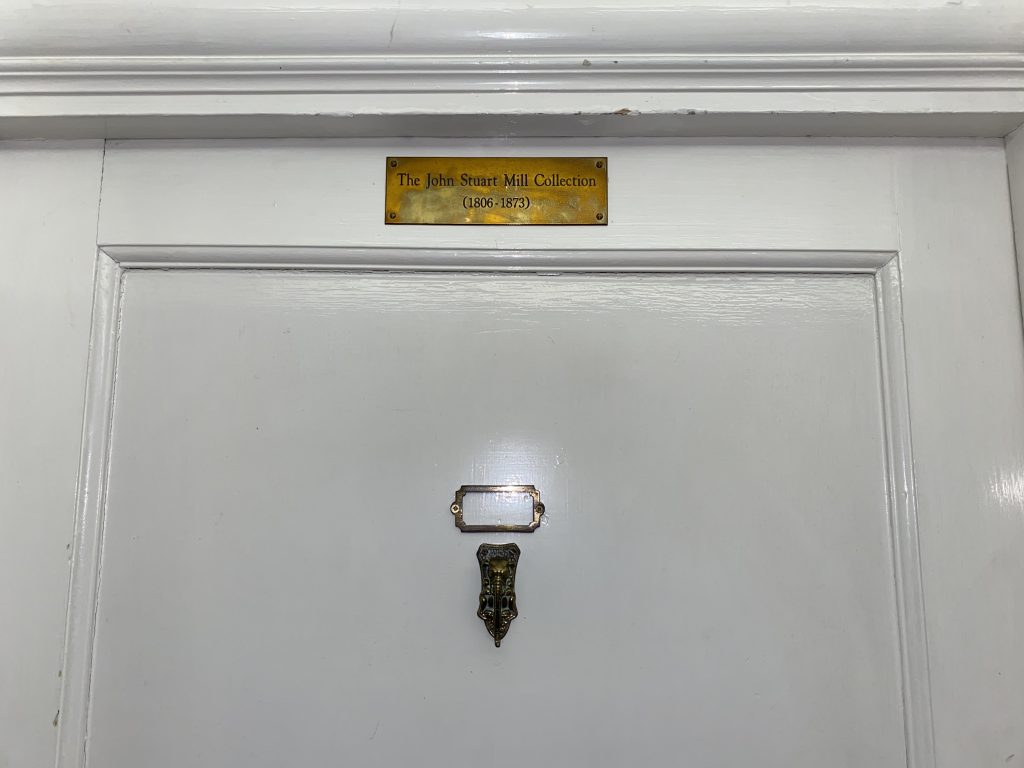Past exhibition
John Stuart Mill Library Event May 11 2023
The Mill Marginalia Online Project

We first exhibited these items at the Open Day in December 2022, but have (at the JCR’s request) put them out again, so that more of our students had a chance to access the collection and see the work being done on the JSM Library (Matthew)
The Mill Marginalia Online Project
This year’s open day focuses on the voluminous marginalia found in John Stuart Mill’s personal copies of some key texts in 19th century philosophy, and the ongoing project to identify, decode, and publicise the meaning and import of the various words, check marks and other non-verbal annotations found in the collection
History of the collection
The ca. 1800 volumes on the shelves in this room are from the Blackheath home of philosopher and political economist John Stuart Mill (1806-1873), and were given to the college in 1905 by his stepdaughter Helen Taylor, at the suggestion of John Morley, who opened the new library building in 1904. The suggestion was seen as very fitting, given that Mary Somerville, after whom the college is named, was the first signatory on Mill’s bill to parliament about votes for women. The books would form a significant part of the early lending collection, and were only removed from open shelves and recollected in 1969, at a time when research into Mill and his contemporaries was on the increase (as witnessed by the publication of his Collected Works, seen on the shelves to the left of the window).
Fundraising and conservation
The recollection of the library was funded by the Pilgrim Trust, and the collection has been consulted by researchers since then, but a marked increase in interest in the books, and specifically the marginalia, occurred after Frank Prochaska’s article in History Today (v.63, iss.9, September 9, 2013) (printed copy to the side, or here), “Mill and Emerson: Sense and Nonsense”. Prompted by this, successful fundraising was undertaken to pay for conservation of parts of the collection which were badly in need of it (including the Emerson, whose protective box is in the case alongside it); this work has been done by the Oxford Conservation Consortium, was the focus of a previous open day, and was mentioned in a Guardian article of 2018, about the project as a whole.
Mill Marginalia Online
Fundraising has also allowed for the collaboration between Somerville and the University of Alabama, the results of which are gradually being made available online at millmarginalia.org. The current version of the website can be browsed and searched on the tablet in the corner.
As well as the website, Prof. Albert Pionke, the lead investigator on the project, has published several articles about the possible meaning and import of the marginalia. Prochaska (2013) focused on very clear verbal marginalia (a transcript of the writing on the title page of the Emerson is alongside it in the display case), but Pionke’s article in ICLEA 39 (2020) highlights the wealth of other types of markings with which Mill annotated texts. This article focuses on Mill’s reading of the works of Auguste Comte.
On display is Mill’s copy of Synthèse subjective (1856), open at page 111: Mill has (as he does throughout the works of Comte in his possession) marked sections with a cross in the margin; we know from his own reviews of the works (also on display here) that Mill quoted or referenced such passages in his reviews, so this cross mark seems very clearly to point to Mill marking up his own copy for review – the passage of Synthèse in question is heavily critiqued by Mill, and the review as published in the Collected Works is open at the appropriate page on the desk.
As well as the verbal type in the Emerson, and the non-verbal mark type in the Comte, the MMO project has identified over 70 others, but perhaps most surprising are things such as those found in Mill’s copy of Vinnius, on display in the third case. Rather than anything to do with the particular text, they are cut-out figures, 2 commercially produced and punched out of a magazine, and the other fairly clearly handmade in imitation of the others. Pionke talks about these in an article in The Conversation from 2018, positing several possible origins and reasons why they were kept in this book (because it was heavy and could act as a good press for keeping them flat, in all likelihood!)
The project is still ongoing, with the marginalia now fully listed, but not yet fully photographed, processed and searchable – more on that next year!